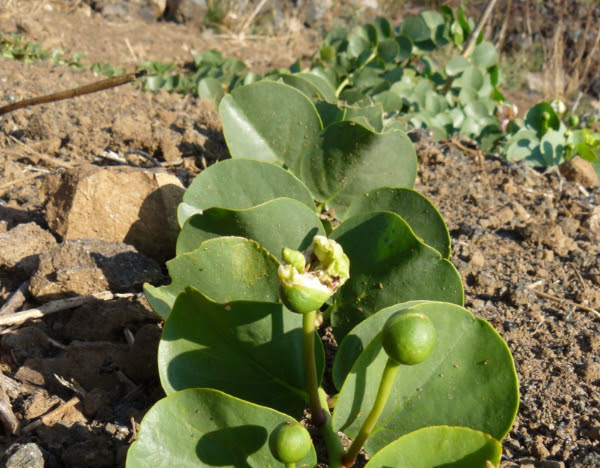Admit it: for years, you’ve had a jar of capers sitting in the door of your fridge, forgotten amongst the mustards and jams. They’re packed in cheap vinegar and that’s pretty much all they taste like. It’s no wonder you never used them except for that one recipe you now forget. Why bother?
I used to feel the same way—until I spent a week on Caper Island.
Caper Island—or, if you’d like to use its real name, Pantelleria—is a small island in the Mediterranean midway between Tunisia and Sicily. With 37 miles of sea separating it from the next closest patch of land, it’s as isolated as anywhere I’ve ever been. Despite its location in the middle of the sea, the people of Pantelleria have always been farmers, not fishers.
Those farmers have their work cut out for them. The island has no source of fresh water and gets little rain. The soil is volcanic and very fertile, but that soil stretches across steep mountain slopes. And all year long, relentless winds blow across the island. (In fact, the name “Pantelleria” comes from the thousand-year-old Arabic name for the island, Bent El Riah, or “daughter of the winds.”)
In terraced fields carved into the mountainsides over the last millenium, the people of Pantelleria—called Pantescans—grow squat bushes of Zibbibo grapes and groves of Lilliputian olive trees that reach only as high as my waist. Many families also raise eggplants, peppers, tomatoes, potatoes, herbs, and perhaps a citrus tree in their home gardens. But Pantelleria is probably best known for its capers. Capers are ubiquitous on the island: they sprout wild from boulders along the narrow paths up to the island’s natural volcanic saunas; they pop unbidden out of chinks in stone walls; they are carefully farmed in neat rows in dusty fields.
The caper that we eat is the flower bud of the caper plant that has not yet blossomed.
They don’t look like a very promising source of food. On the island, everyone told me that the raw buds are inedible. They’re not poisonous (as I am happy to report from personal experience), but they’re not all that tasty, either. The flavor is something like a green pea, but more bitter and with a harsh peppery bite not unlike arugula. Instead of eating them raw, the buds are cured. Curing serves two purposes: it highlights the delicate, floral aromas for which capers are prized, and it preserves them for year-round use.
In other parts of the Mediterranean capers are cured in vinegar or a salt brine. On Pantelleria they use only sea salt. That’s key, and it’s a huge part of what makes the capers from Pantelleria so great. Partly the salt curing is done for for flavor—curing in vinegar can mask the flavor of the caper itself—but mostly it is just a matter of practicality. With no fresh water and little rainfall, Pantescans had no water to spare for caper curing. The capers salt for about three weeks, during which time they undergo a lactic fermentation, the same process used to make sauerkraut or kimchi. After that time the curing salt is removed and the capers are stored in fresh sea salt until they’re ready to be packed up and shipped out.
Pantelleria’s salted capers are firm, green, floral, savory. Their briny aroma hits you the moment you open the jar. They taste like the sea and the sun and a hot Mediterranean hillside. They pack all this flavor in a tiny parcel no bigger than a Maine blueberry. In other words, they’re a far cry from those mushy, bland capers buried in your fridge.
During my time on Pantelleria I ate capers at nearly every meal.
One lunch stands out in my memory. I ate in a small walled garden under the branches of an orange tree laden with still-green fruit. An antipasto plate of fresh, milky tuma cheese, sun dried tomatoes, and fat purple olives included a pile of small capers. A long, tubular pasta was served sauced with a caper and almond pesto and topped with crunchy toasted breadcrumbs. There was insalata pantesca, a salad of cooked potatoes, raw tomatoes and onion, and capers. An outstanding swordfish steak came garnished with chopped tomato and a few capers. Only dessert—a boozy passito wine gelato—was caper-free. This wasn’t a special, caper-centric menu prepared just for me. It was just lunch. On Pantelleria, capers are used everywhere as a seasoning, almost like we’d use pepper in the US.
To best preserve the texture and flavor of the capers, add them only at the very end of cooking, as you would fresh herbs. However, before adding them, you’ll probably want to rinse them to remove some of the salt. There’s no consensus among Pantescans about the right way to rinse capers; I heard everything from no rinsing at all to soaking them for three to four hours in fresh water. I usually split the difference and soak ’em for maybe 20 minutes, and then when I can I like to use the soaking water in place of salt in my recipe. The best advice I can give you is to taste them as they soak and use them when they taste good to you!
Eight ways to use capers you didn’t know about last Tuesday:
1. Toss a handful of capers in with pasta, tuna, and a splash of lemon juice.
2. Sneak a few capers into tomato sauce served over grilled fish.
3. Top a pizza with mozzarella, sun dried tomatoes, roasted bell pepper, and capers.
4. Add some capers to a chicken braised with onions and parsley.
5. Whip up an omelet with sauteed mushrooms, fresh oregano, and capers.
6. Serve spaghetti sauced with caper pesto and topped with toasted bread crumbs.
7. Make a sauce Grenobloise with browned butter, capers, parsley, and lemon, then serve it on trout or sole.
8. Top pork chops with sauteed onions, peppers, and capers.

